Financial Engineering Report: Derivatives and Hedging Strategies
VerifiedAdded on 2021/04/24
|14
|3533
|215
Report
AI Summary
This financial engineering report provides a comprehensive overview of the global derivatives market and its application in the fuel and airline industries. It explores various derivative instruments, including futures, forwards, call options, and swap contracts, used for hedging fuel price risk. The report reviews literature on derivative usage by jet fuel traders and airline companies, detailing the strategies employed and their effectiveness. It critically compares hedging strategies used by companies like Delta and China Aviation Oil, identifying instances where strategies backfired. The report evaluates whether hedging is superior to no hedging, emphasizing the importance of risk management and control mechanisms to prevent misuse of derivatives. The analysis includes case studies, comparisons of different hedging approaches, and recommendations for control mechanisms to protect companies from improper derivative transactions. The report concludes by emphasizing the value of hedging for mitigating risk in volatile markets.
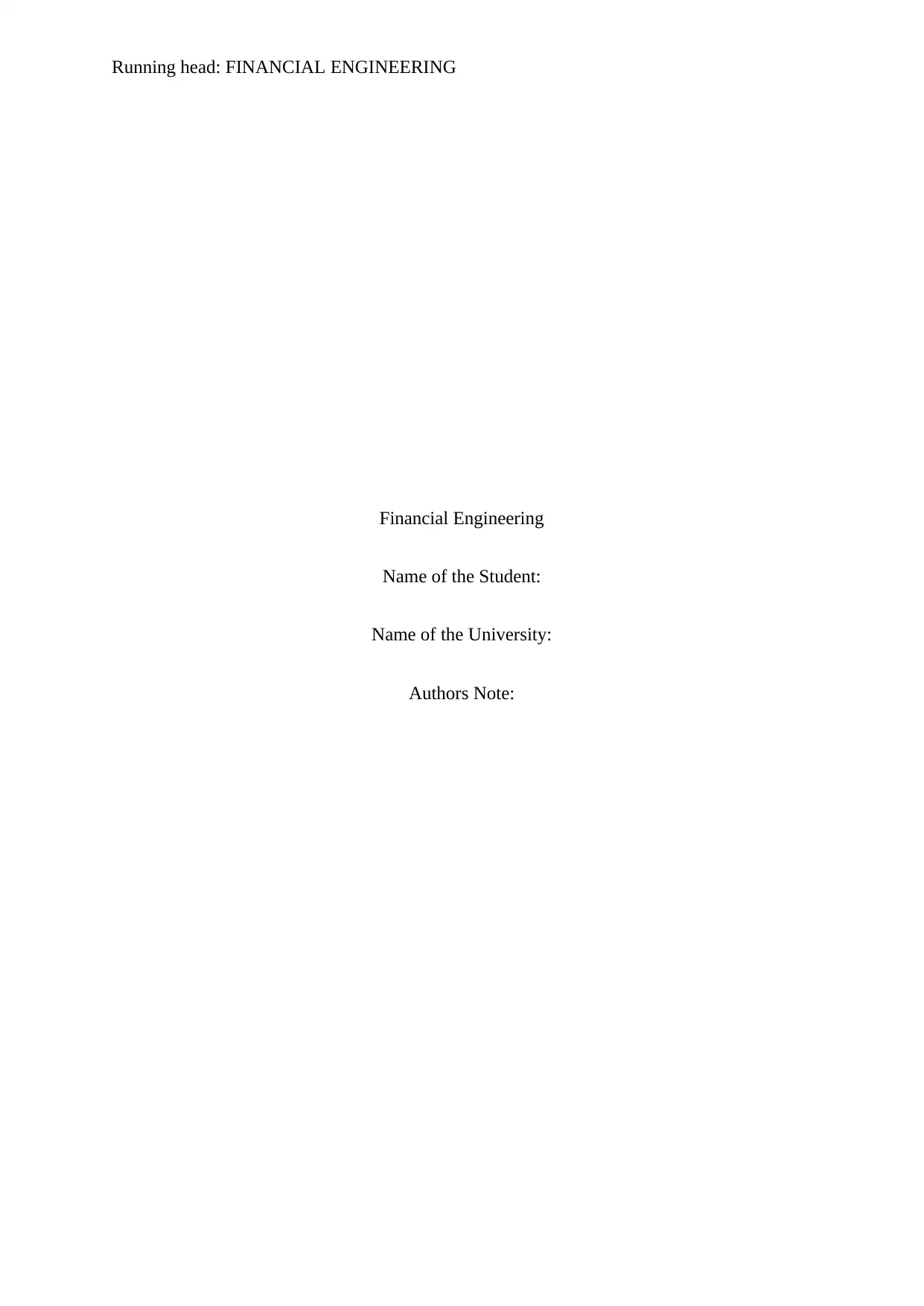
Running head: FINANCIAL ENGINEERING
Financial Engineering
Name of the Student:
Name of the University:
Authors Note:
Financial Engineering
Name of the Student:
Name of the University:
Authors Note:
Paraphrase This Document
Need a fresh take? Get an instant paraphrase of this document with our AI Paraphraser

FINANCIAL ENGINEERING
1
Table of Contents
Introduction:...............................................................................................................................2
Literature review on use of derivatives by jet fuel traders and airline companies for fuel price
hedging:......................................................................................................................................2
Critically comparing on the strategies used by the company, while identifying the position,
which turned against them:........................................................................................................4
Stating after the evaluation whether no hedge is better than hedge:..........................................7
Suggesting control mechanisms that could be used by companies to protect them against
wrong use of derivatives transactions:.......................................................................................8
Conclusion:................................................................................................................................9
Reference and Bibliography:....................................................................................................11
1
Table of Contents
Introduction:...............................................................................................................................2
Literature review on use of derivatives by jet fuel traders and airline companies for fuel price
hedging:......................................................................................................................................2
Critically comparing on the strategies used by the company, while identifying the position,
which turned against them:........................................................................................................4
Stating after the evaluation whether no hedge is better than hedge:..........................................7
Suggesting control mechanisms that could be used by companies to protect them against
wrong use of derivatives transactions:.......................................................................................8
Conclusion:................................................................................................................................9
Reference and Bibliography:....................................................................................................11

FINANCIAL ENGINEERING
2
Introduction:
The overall assessment mainly provides a gist of global derivatives market that is
currently present within the global market. In today's context there are different layers of
contracts and instrument, which is used by investors, bankers, institutions, security fund and
other traders to hedge the risk and increase profits from investment. Without the use of
hedging investors are not able to reduce the risk attributes and increase returns from
investment. Currently the hedging of crude oil is a necessary requirement for all companies
falling under fuel and airline industry. The rising or declining cost of crude oil effect
operation capability of both fuel and allied industries. Consequently, the use future and
forward contracts to hedge their relevant risk from investment. forward and future contracts
are relative instrument that allows the companies to reduce the exposure of volatile prices and
fix their expenses. Future and forward contract are useful in hedging the risk of rising prices,
which might occur due to the instability in supply of crude oil (Bartram 2017). The main aim
of fuel and airline industry is to reduce the cost of acquiring oil and increase the profits in the
operations. However, the fuel industry has a contrary view from Airline industry, as they
prefer rising crude oil prices for increasing the profits. On the other hand, airline industry
needs low-cost fuels to generate high revenues and reduced their expenses for cash outflow.
Therefore, both the industries can use forward and future contracts for reducing the risk from
volatile crude oil prices.
Literature review on use of derivatives by jet fuel traders and airline companies for fuel
price hedging:
Currently there are 4 different types of derivatives that is used by Jet fuel trader’s
aniline companies for hedging their fuel prices. These different types of derivatives relatively
help in reducing of curbing the high risk involved in prices of fuel.
2
Introduction:
The overall assessment mainly provides a gist of global derivatives market that is
currently present within the global market. In today's context there are different layers of
contracts and instrument, which is used by investors, bankers, institutions, security fund and
other traders to hedge the risk and increase profits from investment. Without the use of
hedging investors are not able to reduce the risk attributes and increase returns from
investment. Currently the hedging of crude oil is a necessary requirement for all companies
falling under fuel and airline industry. The rising or declining cost of crude oil effect
operation capability of both fuel and allied industries. Consequently, the use future and
forward contracts to hedge their relevant risk from investment. forward and future contracts
are relative instrument that allows the companies to reduce the exposure of volatile prices and
fix their expenses. Future and forward contract are useful in hedging the risk of rising prices,
which might occur due to the instability in supply of crude oil (Bartram 2017). The main aim
of fuel and airline industry is to reduce the cost of acquiring oil and increase the profits in the
operations. However, the fuel industry has a contrary view from Airline industry, as they
prefer rising crude oil prices for increasing the profits. On the other hand, airline industry
needs low-cost fuels to generate high revenues and reduced their expenses for cash outflow.
Therefore, both the industries can use forward and future contracts for reducing the risk from
volatile crude oil prices.
Literature review on use of derivatives by jet fuel traders and airline companies for fuel
price hedging:
Currently there are 4 different types of derivatives that is used by Jet fuel trader’s
aniline companies for hedging their fuel prices. These different types of derivatives relatively
help in reducing of curbing the high risk involved in prices of fuel.
⊘ This is a preview!⊘
Do you want full access?
Subscribe today to unlock all pages.

Trusted by 1+ million students worldwide
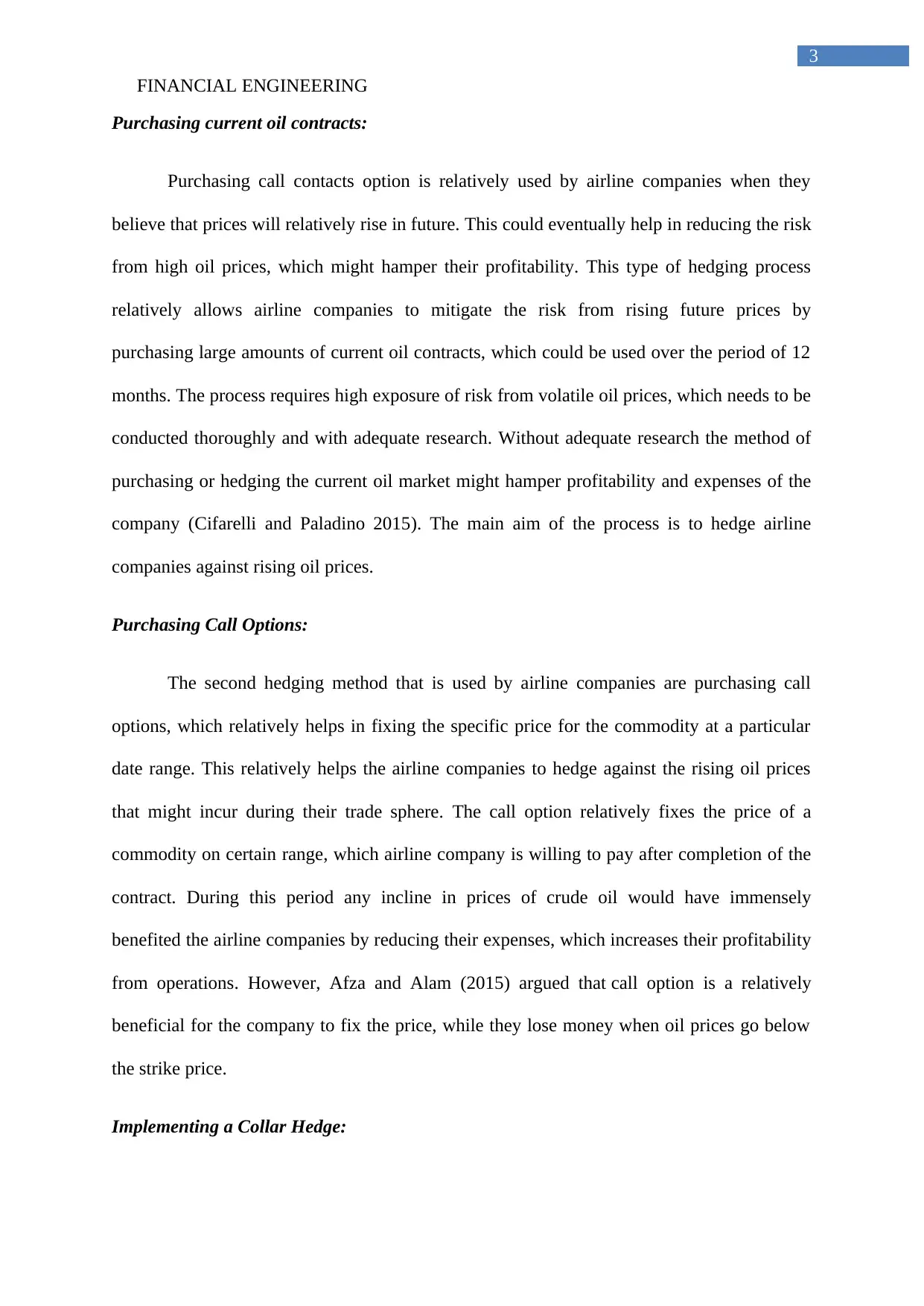
FINANCIAL ENGINEERING
3
Purchasing current oil contracts:
Purchasing call contacts option is relatively used by airline companies when they
believe that prices will relatively rise in future. This could eventually help in reducing the risk
from high oil prices, which might hamper their profitability. This type of hedging process
relatively allows airline companies to mitigate the risk from rising future prices by
purchasing large amounts of current oil contracts, which could be used over the period of 12
months. The process requires high exposure of risk from volatile oil prices, which needs to be
conducted thoroughly and with adequate research. Without adequate research the method of
purchasing or hedging the current oil market might hamper profitability and expenses of the
company (Cifarelli and Paladino 2015). The main aim of the process is to hedge airline
companies against rising oil prices.
Purchasing Call Options:
The second hedging method that is used by airline companies are purchasing call
options, which relatively helps in fixing the specific price for the commodity at a particular
date range. This relatively helps the airline companies to hedge against the rising oil prices
that might incur during their trade sphere. The call option relatively fixes the price of a
commodity on certain range, which airline company is willing to pay after completion of the
contract. During this period any incline in prices of crude oil would have immensely
benefited the airline companies by reducing their expenses, which increases their profitability
from operations. However, Afza and Alam (2015) argued that call option is a relatively
beneficial for the company to fix the price, while they lose money when oil prices go below
the strike price.
Implementing a Collar Hedge:
3
Purchasing current oil contracts:
Purchasing call contacts option is relatively used by airline companies when they
believe that prices will relatively rise in future. This could eventually help in reducing the risk
from high oil prices, which might hamper their profitability. This type of hedging process
relatively allows airline companies to mitigate the risk from rising future prices by
purchasing large amounts of current oil contracts, which could be used over the period of 12
months. The process requires high exposure of risk from volatile oil prices, which needs to be
conducted thoroughly and with adequate research. Without adequate research the method of
purchasing or hedging the current oil market might hamper profitability and expenses of the
company (Cifarelli and Paladino 2015). The main aim of the process is to hedge airline
companies against rising oil prices.
Purchasing Call Options:
The second hedging method that is used by airline companies are purchasing call
options, which relatively helps in fixing the specific price for the commodity at a particular
date range. This relatively helps the airline companies to hedge against the rising oil prices
that might incur during their trade sphere. The call option relatively fixes the price of a
commodity on certain range, which airline company is willing to pay after completion of the
contract. During this period any incline in prices of crude oil would have immensely
benefited the airline companies by reducing their expenses, which increases their profitability
from operations. However, Afza and Alam (2015) argued that call option is a relatively
beneficial for the company to fix the price, while they lose money when oil prices go below
the strike price.
Implementing a Collar Hedge:
Paraphrase This Document
Need a fresh take? Get an instant paraphrase of this document with our AI Paraphraser
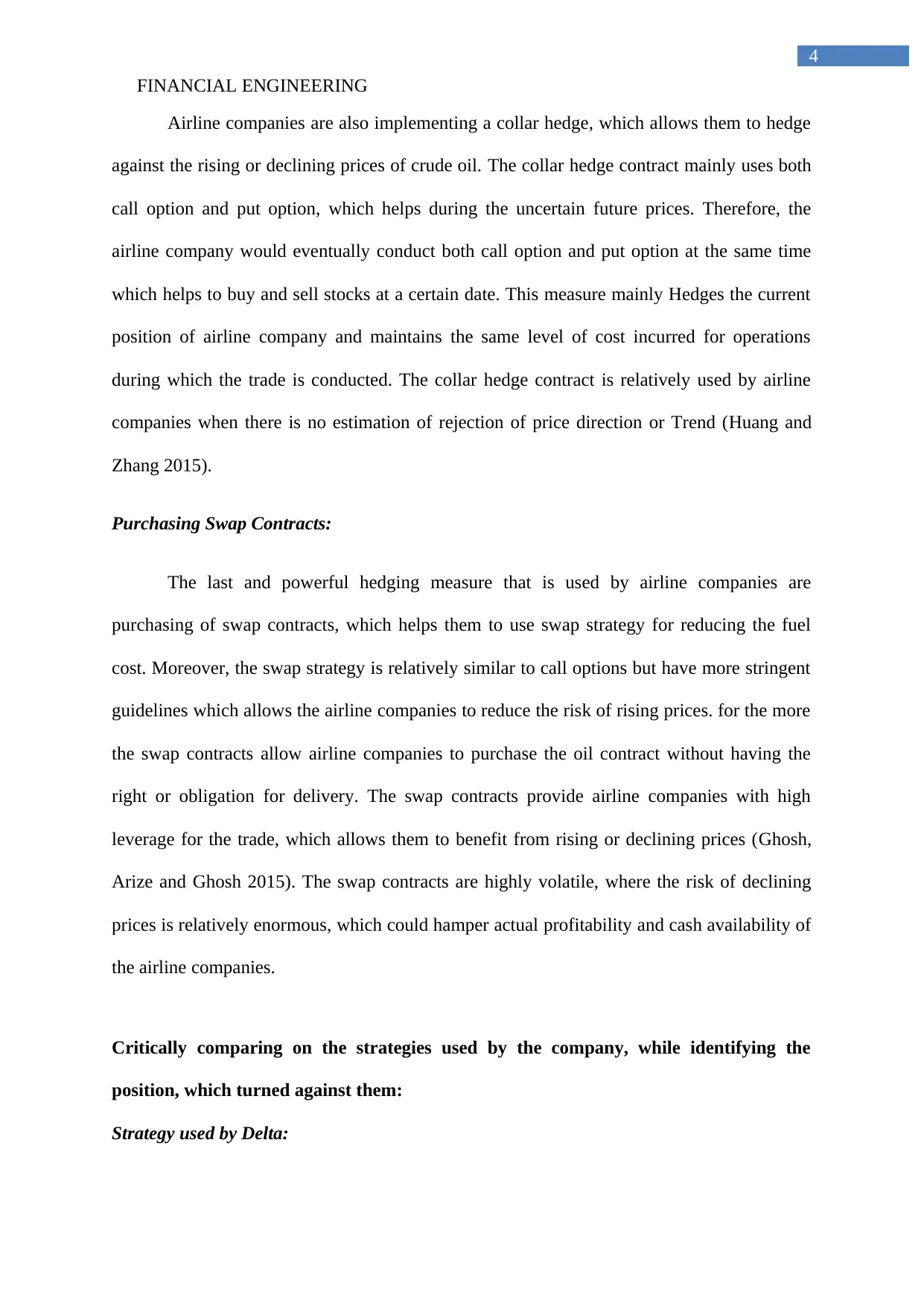
FINANCIAL ENGINEERING
4
Airline companies are also implementing a collar hedge, which allows them to hedge
against the rising or declining prices of crude oil. The collar hedge contract mainly uses both
call option and put option, which helps during the uncertain future prices. Therefore, the
airline company would eventually conduct both call option and put option at the same time
which helps to buy and sell stocks at a certain date. This measure mainly Hedges the current
position of airline company and maintains the same level of cost incurred for operations
during which the trade is conducted. The collar hedge contract is relatively used by airline
companies when there is no estimation of rejection of price direction or Trend (Huang and
Zhang 2015).
Purchasing Swap Contracts:
The last and powerful hedging measure that is used by airline companies are
purchasing of swap contracts, which helps them to use swap strategy for reducing the fuel
cost. Moreover, the swap strategy is relatively similar to call options but have more stringent
guidelines which allows the airline companies to reduce the risk of rising prices. for the more
the swap contracts allow airline companies to purchase the oil contract without having the
right or obligation for delivery. The swap contracts provide airline companies with high
leverage for the trade, which allows them to benefit from rising or declining prices (Ghosh,
Arize and Ghosh 2015). The swap contracts are highly volatile, where the risk of declining
prices is relatively enormous, which could hamper actual profitability and cash availability of
the airline companies.
Critically comparing on the strategies used by the company, while identifying the
position, which turned against them:
Strategy used by Delta:
4
Airline companies are also implementing a collar hedge, which allows them to hedge
against the rising or declining prices of crude oil. The collar hedge contract mainly uses both
call option and put option, which helps during the uncertain future prices. Therefore, the
airline company would eventually conduct both call option and put option at the same time
which helps to buy and sell stocks at a certain date. This measure mainly Hedges the current
position of airline company and maintains the same level of cost incurred for operations
during which the trade is conducted. The collar hedge contract is relatively used by airline
companies when there is no estimation of rejection of price direction or Trend (Huang and
Zhang 2015).
Purchasing Swap Contracts:
The last and powerful hedging measure that is used by airline companies are
purchasing of swap contracts, which helps them to use swap strategy for reducing the fuel
cost. Moreover, the swap strategy is relatively similar to call options but have more stringent
guidelines which allows the airline companies to reduce the risk of rising prices. for the more
the swap contracts allow airline companies to purchase the oil contract without having the
right or obligation for delivery. The swap contracts provide airline companies with high
leverage for the trade, which allows them to benefit from rising or declining prices (Ghosh,
Arize and Ghosh 2015). The swap contracts are highly volatile, where the risk of declining
prices is relatively enormous, which could hamper actual profitability and cash availability of
the airline companies.
Critically comparing on the strategies used by the company, while identifying the
position, which turned against them:
Strategy used by Delta:
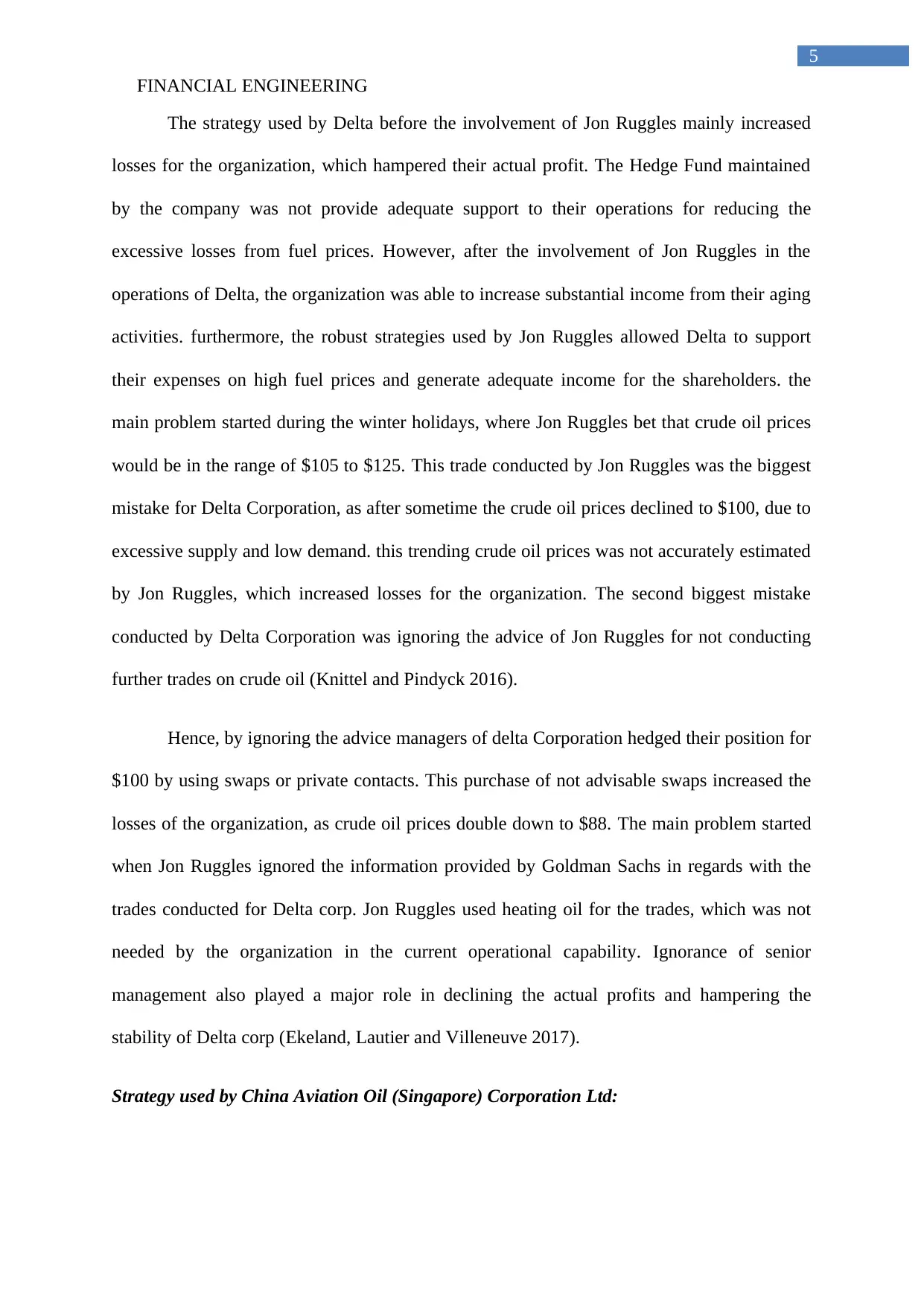
FINANCIAL ENGINEERING
5
The strategy used by Delta before the involvement of Jon Ruggles mainly increased
losses for the organization, which hampered their actual profit. The Hedge Fund maintained
by the company was not provide adequate support to their operations for reducing the
excessive losses from fuel prices. However, after the involvement of Jon Ruggles in the
operations of Delta, the organization was able to increase substantial income from their aging
activities. furthermore, the robust strategies used by Jon Ruggles allowed Delta to support
their expenses on high fuel prices and generate adequate income for the shareholders. the
main problem started during the winter holidays, where Jon Ruggles bet that crude oil prices
would be in the range of $105 to $125. This trade conducted by Jon Ruggles was the biggest
mistake for Delta Corporation, as after sometime the crude oil prices declined to $100, due to
excessive supply and low demand. this trending crude oil prices was not accurately estimated
by Jon Ruggles, which increased losses for the organization. The second biggest mistake
conducted by Delta Corporation was ignoring the advice of Jon Ruggles for not conducting
further trades on crude oil (Knittel and Pindyck 2016).
Hence, by ignoring the advice managers of delta Corporation hedged their position for
$100 by using swaps or private contacts. This purchase of not advisable swaps increased the
losses of the organization, as crude oil prices double down to $88. The main problem started
when Jon Ruggles ignored the information provided by Goldman Sachs in regards with the
trades conducted for Delta corp. Jon Ruggles used heating oil for the trades, which was not
needed by the organization in the current operational capability. Ignorance of senior
management also played a major role in declining the actual profits and hampering the
stability of Delta corp (Ekeland, Lautier and Villeneuve 2017).
Strategy used by China Aviation Oil (Singapore) Corporation Ltd:
5
The strategy used by Delta before the involvement of Jon Ruggles mainly increased
losses for the organization, which hampered their actual profit. The Hedge Fund maintained
by the company was not provide adequate support to their operations for reducing the
excessive losses from fuel prices. However, after the involvement of Jon Ruggles in the
operations of Delta, the organization was able to increase substantial income from their aging
activities. furthermore, the robust strategies used by Jon Ruggles allowed Delta to support
their expenses on high fuel prices and generate adequate income for the shareholders. the
main problem started during the winter holidays, where Jon Ruggles bet that crude oil prices
would be in the range of $105 to $125. This trade conducted by Jon Ruggles was the biggest
mistake for Delta Corporation, as after sometime the crude oil prices declined to $100, due to
excessive supply and low demand. this trending crude oil prices was not accurately estimated
by Jon Ruggles, which increased losses for the organization. The second biggest mistake
conducted by Delta Corporation was ignoring the advice of Jon Ruggles for not conducting
further trades on crude oil (Knittel and Pindyck 2016).
Hence, by ignoring the advice managers of delta Corporation hedged their position for
$100 by using swaps or private contacts. This purchase of not advisable swaps increased the
losses of the organization, as crude oil prices double down to $88. The main problem started
when Jon Ruggles ignored the information provided by Goldman Sachs in regards with the
trades conducted for Delta corp. Jon Ruggles used heating oil for the trades, which was not
needed by the organization in the current operational capability. Ignorance of senior
management also played a major role in declining the actual profits and hampering the
stability of Delta corp (Ekeland, Lautier and Villeneuve 2017).
Strategy used by China Aviation Oil (Singapore) Corporation Ltd:
⊘ This is a preview!⊘
Do you want full access?
Subscribe today to unlock all pages.

Trusted by 1+ million students worldwide
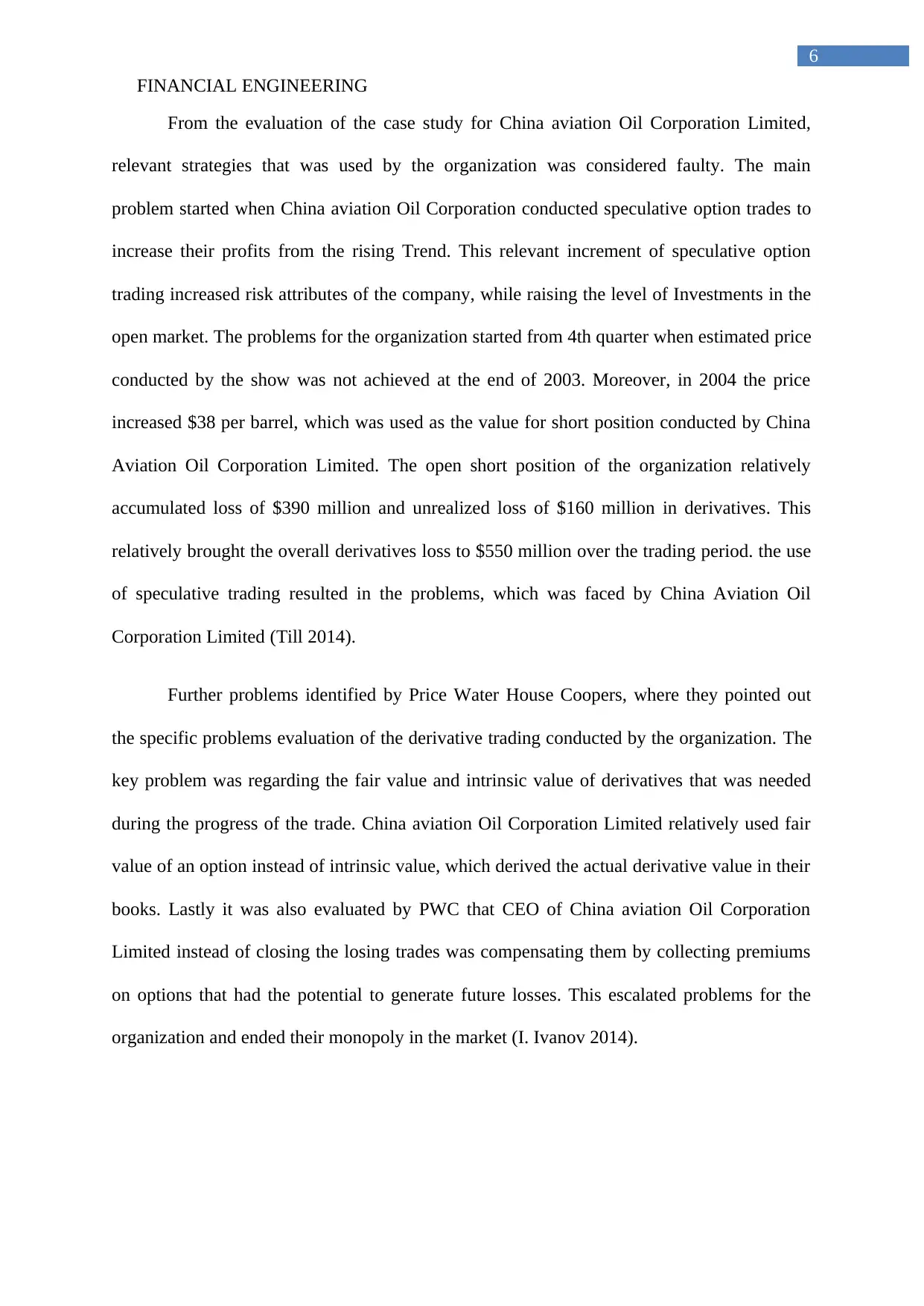
FINANCIAL ENGINEERING
6
From the evaluation of the case study for China aviation Oil Corporation Limited,
relevant strategies that was used by the organization was considered faulty. The main
problem started when China aviation Oil Corporation conducted speculative option trades to
increase their profits from the rising Trend. This relevant increment of speculative option
trading increased risk attributes of the company, while raising the level of Investments in the
open market. The problems for the organization started from 4th quarter when estimated price
conducted by the show was not achieved at the end of 2003. Moreover, in 2004 the price
increased $38 per barrel, which was used as the value for short position conducted by China
Aviation Oil Corporation Limited. The open short position of the organization relatively
accumulated loss of $390 million and unrealized loss of $160 million in derivatives. This
relatively brought the overall derivatives loss to $550 million over the trading period. the use
of speculative trading resulted in the problems, which was faced by China Aviation Oil
Corporation Limited (Till 2014).
Further problems identified by Price Water House Coopers, where they pointed out
the specific problems evaluation of the derivative trading conducted by the organization. The
key problem was regarding the fair value and intrinsic value of derivatives that was needed
during the progress of the trade. China aviation Oil Corporation Limited relatively used fair
value of an option instead of intrinsic value, which derived the actual derivative value in their
books. Lastly it was also evaluated by PWC that CEO of China aviation Oil Corporation
Limited instead of closing the losing trades was compensating them by collecting premiums
on options that had the potential to generate future losses. This escalated problems for the
organization and ended their monopoly in the market (I. Ivanov 2014).
6
From the evaluation of the case study for China aviation Oil Corporation Limited,
relevant strategies that was used by the organization was considered faulty. The main
problem started when China aviation Oil Corporation conducted speculative option trades to
increase their profits from the rising Trend. This relevant increment of speculative option
trading increased risk attributes of the company, while raising the level of Investments in the
open market. The problems for the organization started from 4th quarter when estimated price
conducted by the show was not achieved at the end of 2003. Moreover, in 2004 the price
increased $38 per barrel, which was used as the value for short position conducted by China
Aviation Oil Corporation Limited. The open short position of the organization relatively
accumulated loss of $390 million and unrealized loss of $160 million in derivatives. This
relatively brought the overall derivatives loss to $550 million over the trading period. the use
of speculative trading resulted in the problems, which was faced by China Aviation Oil
Corporation Limited (Till 2014).
Further problems identified by Price Water House Coopers, where they pointed out
the specific problems evaluation of the derivative trading conducted by the organization. The
key problem was regarding the fair value and intrinsic value of derivatives that was needed
during the progress of the trade. China aviation Oil Corporation Limited relatively used fair
value of an option instead of intrinsic value, which derived the actual derivative value in their
books. Lastly it was also evaluated by PWC that CEO of China aviation Oil Corporation
Limited instead of closing the losing trades was compensating them by collecting premiums
on options that had the potential to generate future losses. This escalated problems for the
organization and ended their monopoly in the market (I. Ivanov 2014).
Paraphrase This Document
Need a fresh take? Get an instant paraphrase of this document with our AI Paraphraser

FINANCIAL ENGINEERING
7
Stating after the evaluation whether no hedge is better than hedge:
Evaluation of case study it could be identified that derivatives a kind of time bomb
which needs to be dealt with extra precautions. this time bomb could eventually hamper
profitability and operational feasibility of the companies or investors if it's not used
adequately. Furthermore, the statement no hedge is better than hedge is not true, as many
multinational companies and investors are using the method to reduce their exposure to
volatility. The current scenario of the financial market is relatively immense, which needs
adequate planning and researching before making any kind of decision. Moreover, the limited
resources with changing demand and supply relatively alters the price of a particular product.
this volatility in prices of shares, currency, and commodity needs to be reduced with the help
of adequate instruments. In this context, Chan et al. (2015) mentioned that with the help of
derivative contracts companies Are investors can used one-to-ten ratio for that trades without
even realizing the actual goods in future.
The derivative instrument was mainly built for multinational companies, hedge fund
manager and big firms that have high exposure in currency and capital market. This
instrument mainly reduced the excessive burden on capital requirement and Allowed
companies to adequately hedge their position against volatile price. The main problem started
when individual investors and any no wise person was using the derivative instrument for
their speculative trades, as instrument provided adequate leverage for speculation conducted
by investors. The investors could use the instrument without even paying the actual amount
of the trade, as it is not required in derivatives. The capital blockage in derivatives is minimal
where investors or companies need to provide one tenth of the investment capital as their
Margin Call to help them continue with the trade.
One of the major failures of derivative instrument can be identified from the financial
crisis of 2008, where silicon swaps were used conductive trades in the ratio 1/20. This
7
Stating after the evaluation whether no hedge is better than hedge:
Evaluation of case study it could be identified that derivatives a kind of time bomb
which needs to be dealt with extra precautions. this time bomb could eventually hamper
profitability and operational feasibility of the companies or investors if it's not used
adequately. Furthermore, the statement no hedge is better than hedge is not true, as many
multinational companies and investors are using the method to reduce their exposure to
volatility. The current scenario of the financial market is relatively immense, which needs
adequate planning and researching before making any kind of decision. Moreover, the limited
resources with changing demand and supply relatively alters the price of a particular product.
this volatility in prices of shares, currency, and commodity needs to be reduced with the help
of adequate instruments. In this context, Chan et al. (2015) mentioned that with the help of
derivative contracts companies Are investors can used one-to-ten ratio for that trades without
even realizing the actual goods in future.
The derivative instrument was mainly built for multinational companies, hedge fund
manager and big firms that have high exposure in currency and capital market. This
instrument mainly reduced the excessive burden on capital requirement and Allowed
companies to adequately hedge their position against volatile price. The main problem started
when individual investors and any no wise person was using the derivative instrument for
their speculative trades, as instrument provided adequate leverage for speculation conducted
by investors. The investors could use the instrument without even paying the actual amount
of the trade, as it is not required in derivatives. The capital blockage in derivatives is minimal
where investors or companies need to provide one tenth of the investment capital as their
Margin Call to help them continue with the trade.
One of the major failures of derivative instrument can be identified from the financial
crisis of 2008, where silicon swaps were used conductive trades in the ratio 1/20. This
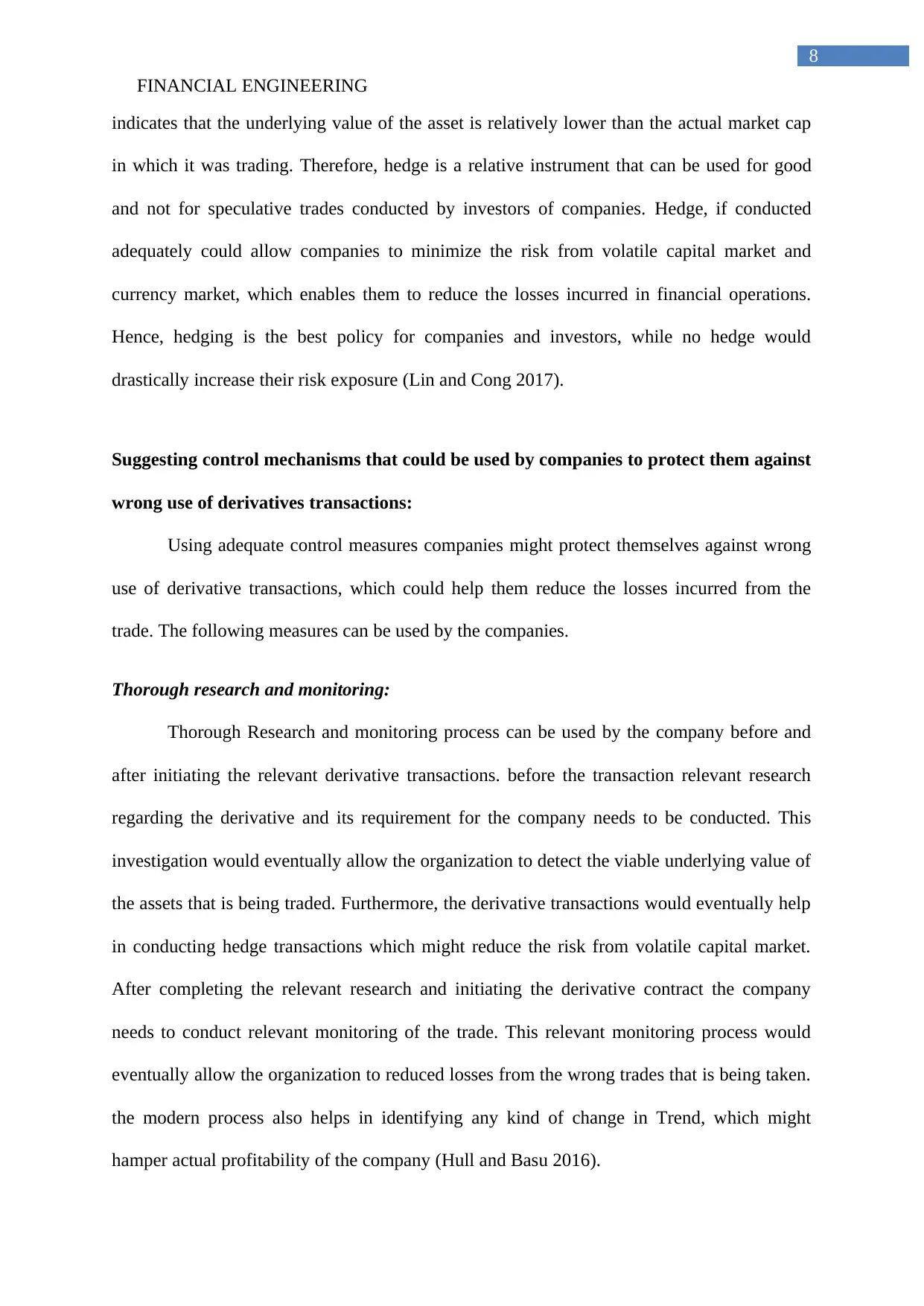
FINANCIAL ENGINEERING
8
indicates that the underlying value of the asset is relatively lower than the actual market cap
in which it was trading. Therefore, hedge is a relative instrument that can be used for good
and not for speculative trades conducted by investors of companies. Hedge, if conducted
adequately could allow companies to minimize the risk from volatile capital market and
currency market, which enables them to reduce the losses incurred in financial operations.
Hence, hedging is the best policy for companies and investors, while no hedge would
drastically increase their risk exposure (Lin and Cong 2017).
Suggesting control mechanisms that could be used by companies to protect them against
wrong use of derivatives transactions:
Using adequate control measures companies might protect themselves against wrong
use of derivative transactions, which could help them reduce the losses incurred from the
trade. The following measures can be used by the companies.
Thorough research and monitoring:
Thorough Research and monitoring process can be used by the company before and
after initiating the relevant derivative transactions. before the transaction relevant research
regarding the derivative and its requirement for the company needs to be conducted. This
investigation would eventually allow the organization to detect the viable underlying value of
the assets that is being traded. Furthermore, the derivative transactions would eventually help
in conducting hedge transactions which might reduce the risk from volatile capital market.
After completing the relevant research and initiating the derivative contract the company
needs to conduct relevant monitoring of the trade. This relevant monitoring process would
eventually allow the organization to reduced losses from the wrong trades that is being taken.
the modern process also helps in identifying any kind of change in Trend, which might
hamper actual profitability of the company (Hull and Basu 2016).
8
indicates that the underlying value of the asset is relatively lower than the actual market cap
in which it was trading. Therefore, hedge is a relative instrument that can be used for good
and not for speculative trades conducted by investors of companies. Hedge, if conducted
adequately could allow companies to minimize the risk from volatile capital market and
currency market, which enables them to reduce the losses incurred in financial operations.
Hence, hedging is the best policy for companies and investors, while no hedge would
drastically increase their risk exposure (Lin and Cong 2017).
Suggesting control mechanisms that could be used by companies to protect them against
wrong use of derivatives transactions:
Using adequate control measures companies might protect themselves against wrong
use of derivative transactions, which could help them reduce the losses incurred from the
trade. The following measures can be used by the companies.
Thorough research and monitoring:
Thorough Research and monitoring process can be used by the company before and
after initiating the relevant derivative transactions. before the transaction relevant research
regarding the derivative and its requirement for the company needs to be conducted. This
investigation would eventually allow the organization to detect the viable underlying value of
the assets that is being traded. Furthermore, the derivative transactions would eventually help
in conducting hedge transactions which might reduce the risk from volatile capital market.
After completing the relevant research and initiating the derivative contract the company
needs to conduct relevant monitoring of the trade. This relevant monitoring process would
eventually allow the organization to reduced losses from the wrong trades that is being taken.
the modern process also helps in identifying any kind of change in Trend, which might
hamper actual profitability of the company (Hull and Basu 2016).
⊘ This is a preview!⊘
Do you want full access?
Subscribe today to unlock all pages.

Trusted by 1+ million students worldwide
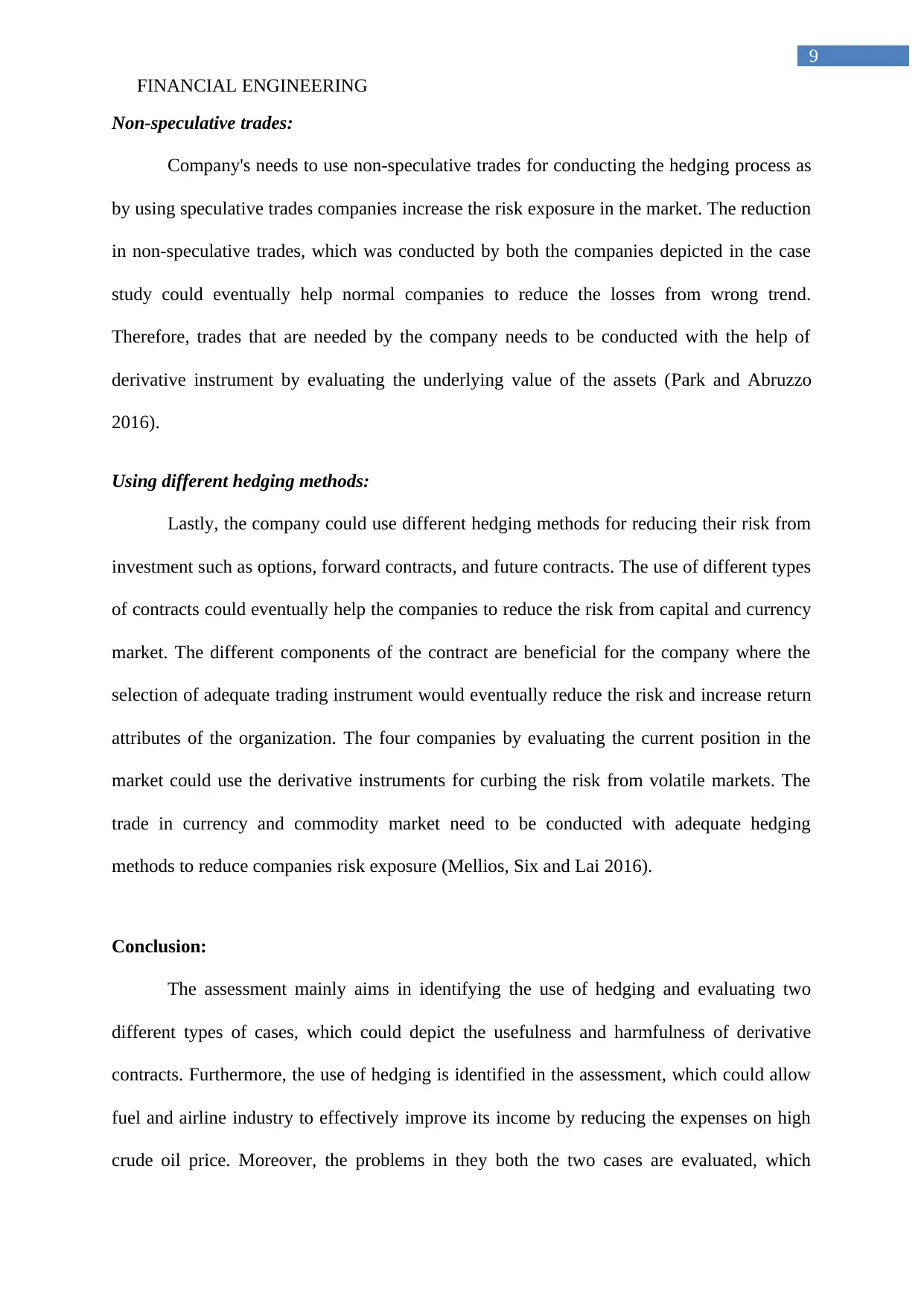
FINANCIAL ENGINEERING
9
Non-speculative trades:
Company's needs to use non-speculative trades for conducting the hedging process as
by using speculative trades companies increase the risk exposure in the market. The reduction
in non-speculative trades, which was conducted by both the companies depicted in the case
study could eventually help normal companies to reduce the losses from wrong trend.
Therefore, trades that are needed by the company needs to be conducted with the help of
derivative instrument by evaluating the underlying value of the assets (Park and Abruzzo
2016).
Using different hedging methods:
Lastly, the company could use different hedging methods for reducing their risk from
investment such as options, forward contracts, and future contracts. The use of different types
of contracts could eventually help the companies to reduce the risk from capital and currency
market. The different components of the contract are beneficial for the company where the
selection of adequate trading instrument would eventually reduce the risk and increase return
attributes of the organization. The four companies by evaluating the current position in the
market could use the derivative instruments for curbing the risk from volatile markets. The
trade in currency and commodity market need to be conducted with adequate hedging
methods to reduce companies risk exposure (Mellios, Six and Lai 2016).
Conclusion:
The assessment mainly aims in identifying the use of hedging and evaluating two
different types of cases, which could depict the usefulness and harmfulness of derivative
contracts. Furthermore, the use of hedging is identified in the assessment, which could allow
fuel and airline industry to effectively improve its income by reducing the expenses on high
crude oil price. Moreover, the problems in they both the two cases are evaluated, which
9
Non-speculative trades:
Company's needs to use non-speculative trades for conducting the hedging process as
by using speculative trades companies increase the risk exposure in the market. The reduction
in non-speculative trades, which was conducted by both the companies depicted in the case
study could eventually help normal companies to reduce the losses from wrong trend.
Therefore, trades that are needed by the company needs to be conducted with the help of
derivative instrument by evaluating the underlying value of the assets (Park and Abruzzo
2016).
Using different hedging methods:
Lastly, the company could use different hedging methods for reducing their risk from
investment such as options, forward contracts, and future contracts. The use of different types
of contracts could eventually help the companies to reduce the risk from capital and currency
market. The different components of the contract are beneficial for the company where the
selection of adequate trading instrument would eventually reduce the risk and increase return
attributes of the organization. The four companies by evaluating the current position in the
market could use the derivative instruments for curbing the risk from volatile markets. The
trade in currency and commodity market need to be conducted with adequate hedging
methods to reduce companies risk exposure (Mellios, Six and Lai 2016).
Conclusion:
The assessment mainly aims in identifying the use of hedging and evaluating two
different types of cases, which could depict the usefulness and harmfulness of derivative
contracts. Furthermore, the use of hedging is identified in the assessment, which could allow
fuel and airline industry to effectively improve its income by reducing the expenses on high
crude oil price. Moreover, the problems in they both the two cases are evaluated, which
Paraphrase This Document
Need a fresh take? Get an instant paraphrase of this document with our AI Paraphraser
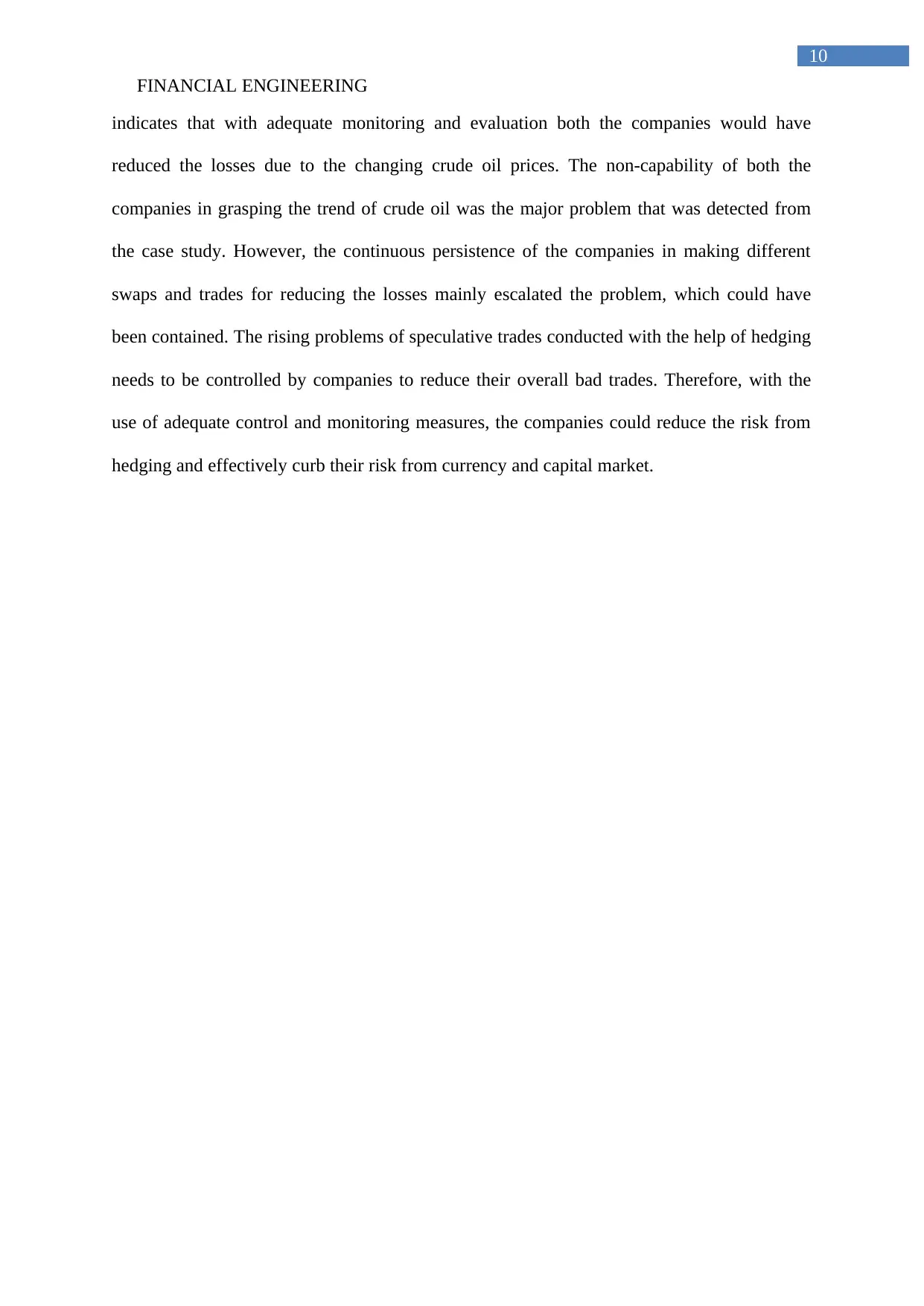
FINANCIAL ENGINEERING
10
indicates that with adequate monitoring and evaluation both the companies would have
reduced the losses due to the changing crude oil prices. The non-capability of both the
companies in grasping the trend of crude oil was the major problem that was detected from
the case study. However, the continuous persistence of the companies in making different
swaps and trades for reducing the losses mainly escalated the problem, which could have
been contained. The rising problems of speculative trades conducted with the help of hedging
needs to be controlled by companies to reduce their overall bad trades. Therefore, with the
use of adequate control and monitoring measures, the companies could reduce the risk from
hedging and effectively curb their risk from currency and capital market.
10
indicates that with adequate monitoring and evaluation both the companies would have
reduced the losses due to the changing crude oil prices. The non-capability of both the
companies in grasping the trend of crude oil was the major problem that was detected from
the case study. However, the continuous persistence of the companies in making different
swaps and trades for reducing the losses mainly escalated the problem, which could have
been contained. The rising problems of speculative trades conducted with the help of hedging
needs to be controlled by companies to reduce their overall bad trades. Therefore, with the
use of adequate control and monitoring measures, the companies could reduce the risk from
hedging and effectively curb their risk from currency and capital market.
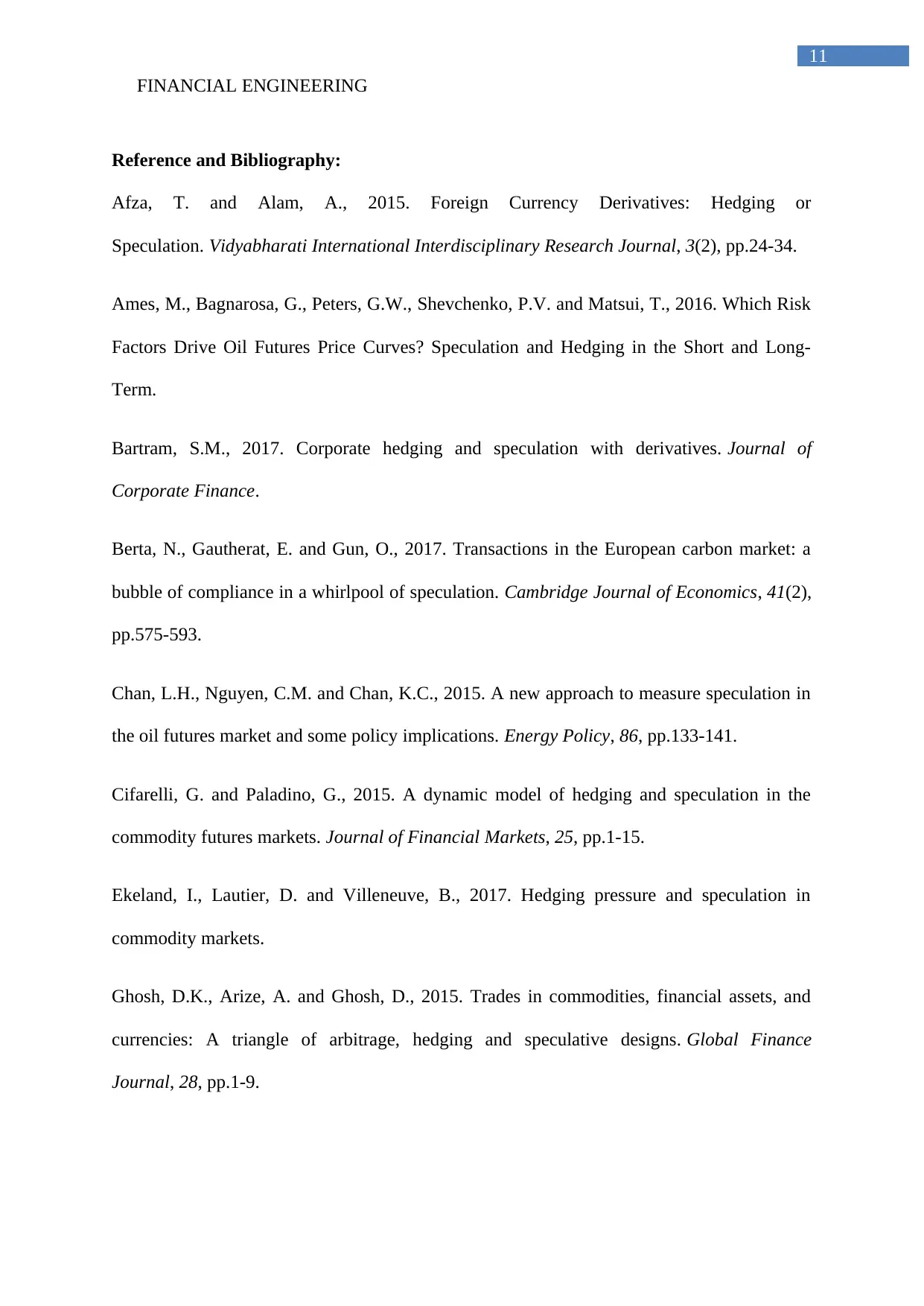
FINANCIAL ENGINEERING
11
Reference and Bibliography:
Afza, T. and Alam, A., 2015. Foreign Currency Derivatives: Hedging or
Speculation. Vidyabharati International Interdisciplinary Research Journal, 3(2), pp.24-34.
Ames, M., Bagnarosa, G., Peters, G.W., Shevchenko, P.V. and Matsui, T., 2016. Which Risk
Factors Drive Oil Futures Price Curves? Speculation and Hedging in the Short and Long-
Term.
Bartram, S.M., 2017. Corporate hedging and speculation with derivatives. Journal of
Corporate Finance.
Berta, N., Gautherat, E. and Gun, O., 2017. Transactions in the European carbon market: a
bubble of compliance in a whirlpool of speculation. Cambridge Journal of Economics, 41(2),
pp.575-593.
Chan, L.H., Nguyen, C.M. and Chan, K.C., 2015. A new approach to measure speculation in
the oil futures market and some policy implications. Energy Policy, 86, pp.133-141.
Cifarelli, G. and Paladino, G., 2015. A dynamic model of hedging and speculation in the
commodity futures markets. Journal of Financial Markets, 25, pp.1-15.
Ekeland, I., Lautier, D. and Villeneuve, B., 2017. Hedging pressure and speculation in
commodity markets.
Ghosh, D.K., Arize, A. and Ghosh, D., 2015. Trades in commodities, financial assets, and
currencies: A triangle of arbitrage, hedging and speculative designs. Global Finance
Journal, 28, pp.1-9.
11
Reference and Bibliography:
Afza, T. and Alam, A., 2015. Foreign Currency Derivatives: Hedging or
Speculation. Vidyabharati International Interdisciplinary Research Journal, 3(2), pp.24-34.
Ames, M., Bagnarosa, G., Peters, G.W., Shevchenko, P.V. and Matsui, T., 2016. Which Risk
Factors Drive Oil Futures Price Curves? Speculation and Hedging in the Short and Long-
Term.
Bartram, S.M., 2017. Corporate hedging and speculation with derivatives. Journal of
Corporate Finance.
Berta, N., Gautherat, E. and Gun, O., 2017. Transactions in the European carbon market: a
bubble of compliance in a whirlpool of speculation. Cambridge Journal of Economics, 41(2),
pp.575-593.
Chan, L.H., Nguyen, C.M. and Chan, K.C., 2015. A new approach to measure speculation in
the oil futures market and some policy implications. Energy Policy, 86, pp.133-141.
Cifarelli, G. and Paladino, G., 2015. A dynamic model of hedging and speculation in the
commodity futures markets. Journal of Financial Markets, 25, pp.1-15.
Ekeland, I., Lautier, D. and Villeneuve, B., 2017. Hedging pressure and speculation in
commodity markets.
Ghosh, D.K., Arize, A. and Ghosh, D., 2015. Trades in commodities, financial assets, and
currencies: A triangle of arbitrage, hedging and speculative designs. Global Finance
Journal, 28, pp.1-9.
⊘ This is a preview!⊘
Do you want full access?
Subscribe today to unlock all pages.

Trusted by 1+ million students worldwide
1 out of 14
Related Documents
Your All-in-One AI-Powered Toolkit for Academic Success.
+13062052269
info@desklib.com
Available 24*7 on WhatsApp / Email
![[object Object]](/_next/static/media/star-bottom.7253800d.svg)
Unlock your academic potential
Copyright © 2020–2025 A2Z Services. All Rights Reserved. Developed and managed by ZUCOL.





